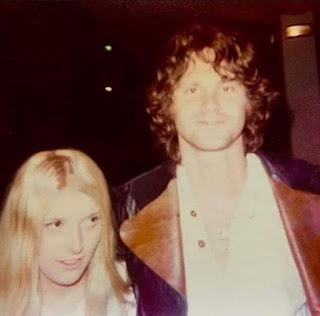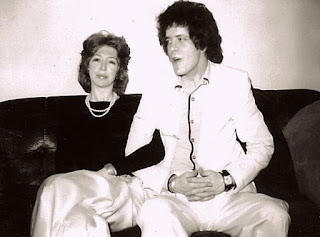There’s a thrilling moment a little before the halfway point of Amazon’s new limited series “Daisy Jones & the Six” in which two stars collide. The ethereal vocalist Daisy Jones (Riley Keough) has been invited to perform her collaboration with a rising rock band, but crashes the stage a bit early and then refuses to leave after her one song has been performed. Daisy and the Six’s lead singer Billy (Sam Claflin) share the microphone for a while, if “share” is the word for what one does in a battle for territory; faces close together, they’re competing for a claim on the song they sing, competing to be heard. That rivalry is the essence of “Daisy Jones & the Six,” a flawed but compelling adaptation of Taylor Jenkins Reid’s 2019 novel of the same name. Reid has described her novel as “a Fleetwood Mac vibe,” if not precisely drawn from Fleetwood Mac’s story — and, as with the real-life Stevie Nicks and Lindsey Buckingham, the two musicians at the center of this fictional group generate as much drama as they do music. Unlike Fleetwood Mac, Daisy Jones & the Six definitively break up in 1977, which we’re told at the start. As we watch Daisy, in the 1970s, stomp over the Six in an act of willful spotlight-seizing, we hear Daisy, in the 1990s, tell us that this was simply beyond her control.
“They wouldn’t let me leave!,” she laughs. We’re being told this story by characters looking back with regret. There’s little of the swirling heedlessness of blossoming attraction here, Billy is trying to keep himself from falling in love: At least notionally committed to the mother of his child (Camila Morrone). And Claflin, never more watchable than when he’s watching Daisy, sells the struggle nicely. But then, Daisy is primarily interested in herself — which is not to say she’s a narcissist, just someone who acknowledges she’s a born star. Daisy’s personality is huge, but it’s not just the band over which she’s running roughshod — it’s the show. Source: hollywoodgossip.co.in
A new book about The Doors and Jim Morrison seen from the road manager Vince Treanor: Behind The Doors. The Story Of A Legendary Band's Road Manager (2023) will not be available for purchase through Amazon or international bookstores. Behind The Doors. The Story Of A Legendary Band's Road Manager can only be ordered directly from the publisher Aldus Boek Compagnie, from Netherlands. Source: www.aldusboekcompagnie.nl
David Warren: Was the glue within The Doors falling apart?
Vince Treanor: After Jim Morrison's death, everybody was shattered, everybody was devastated. It was a case of a reformation of the band. It was a different sound and music. It wasn't The Doors anymore. I knew when I heard the music that this was not good. This just wasn't The Doors and it wasn't going to be a success. Nevertheless, we did the 1971 tour, the four performances, and sure enough, people did not like it. When the five guys played Doors pieces, the audience was ecstatic, really happy, clapping and cheering, when they played the new music, the excitement just wasn't there, they didn't have their hearts in it.
David Warren: A lot of rumors have been said to come from the 1980 biography No One Here Gets Out Alive.
Vince Treanor: That book was not factual. It's Danny Sugerman's dream about making himself an important figure in Jim and Pam's life. He was 14 at the time and claimed to be Jim's confidant. You have a 14-year-old who claims to be the confidant for a 24-year-old alcoholic. Danny was nothing more than a pest, he was a groupie. And I said so in the book. He was constantly trying to sneak into rehearsals, and we had a way to getting him out. Many times, he tried to ingratiate himself to Kathy, by going up and down saying 'I'll open the fan mail' so he hung around the Office, and every once in a while, Bill Siddons would give him some money and tell him 'Go over get me something to drink', sending him on silly errands just to get out of the place but he was nothing more than a pest. He claimed he helped The Doors to move into their new office. He didn't do any such a thing. He was a boy in school, it was 1968, he was 14 years old. What kind of an idiot has a boy moving The Doors into their new Office?
DW: Did it ever cross your mind that Jim Morrison would never return from Paris or that he'd die at such a young age?
VT: No, nobody suspected that, why would you believe that? Jim had called John a couple of weeks before he died and he said 'I'm feeling better, I wrote some new stuff and stopped drinking, I've cleaned myself up, I realize all the stupid mistakes that I made and I'd like to come back. How about we consider to get together again, you can look at my new stuff and we can go on.' I think Jim called John because he was the one who was adamant that he would never play with Jim on stage again. He was trying to let John know that things were different, that he was cleaned up, and two weeks later he was dead. Nobody suspected that, why would we? There were a couple of post cards and a letter suggesting that things were going well. He and Pam were enjoying their stay in Paris and he was fine. Pamela Courson was a terrible influence, she was one of the sources of his disquietude, they fought often and violently.
VT: Absolutely. First, she was a junkie, she was manipulative, she had him buying her heroin. They argued a lot. She had him buying all the clothes for her boutique Themis and then she gave the clothes away to her friends, Jim would be buying more clothes and she'd give them away to her friends. The whole place was a den of iniquity. She and her heroin buddies would be over there shooting up and smoking grass, while sitting on the floor telling each other how wonderful the world was, while Jim was out there trying to earn money, at that time he was doing HWY. She was one of the causes of Miami's debacle. First, Jim had seen the Living Theater performance, second he had a violent fight with Pam before he got on the plane, then he was totally drunk by the time he got to Miami. When he heard about the Miami promoter cheating him, and he was determined not to do a show in Miami, that was why there was so much talking and not so much singing. You could talk to him when he was sober, and it was interesting cause he could talk about things that people didn't know, understand and didn't think about. That made him seem extremely brilliant.
The times have changed for the worse. I like steam locomotives, rockets, electronics, I love the machinery, all the things that made the United States great, the industry that made America great. America lost its heavy industry and will never be great again until the United States wakes up and realizes it handed its technology to China and they made China not only strong but a strong enemy. That was a stupid thing to do. That's what greed does, a lack of foresight, and the fact that you can get into bed with the politically opposed, and make a goal of it and you can't do it. All you do is make them a stronger enemy. Source: www.popexpresso.com
-Patricia Butler: In the spring of 1973, Pamela Courson was living in San Francisco with Michael Verjaska. She had been friends with Michael for a few years but they became lovers after Jim died. She was also dating Randy Ralston. My sources of information about Pamela not being a heavy heroin user before Jim Morrison's death are: the LAPD report; Pamela's autopsy report; January Jensen and Ellen Sander's recollections; Ellen Sander hastened to refute Pamela's rumored heroin addiction while she was in Paris, and after. "When she stayed with me, I did not see her do anything like that. And if she was a heroin addict in Paris -- it's awfully hard to hide it. It's not like you can put it down for a week. I saw no evidence of any kind of hard drug usage while she was at my house, and I was with her almost constantly." January Jensen, who lived in nearby Sausalito and became Pamela's confidante, echoed Ellen's observations.
-Frank Lisciandro: I read the so-called first-hand account written by Alain Ronay which was published in Paris Match magazine. He contends that he was there and that he knew what happened. Then again, I spoke with Mrs. Courson—Pamela’s mother—who told me what Pamela told her over the last few years, which contradicts what Alain Ronay wrote. This was a private conversation, so I never have written about it or told anyone in the press. What I will say is that if what Pamela told her mother was true, and if I understood what her mother told me, then it would contradict the major points of Alain Ronay’s version of events. There’s been a lot of talk that Pamela was some sort of heroin junkie. I don’t know that for a fact; I only know that from hearsay. I never saw any marks on her arms, and I never heard her or Jim ever talk about heroin at any time. Likewise, Babe Hill admits to taking nearly every drug known to man with Jim, but he categorically denies that Jim ever used heroin. With the exception of Pamela, there is no one who spent more personal time with Jim than Babe. And anyone who says they were around Jim as much as Babe, is just not being truthful. I think Babe would have seen heroin use by Jim. Heroin was definitely around so Jim could have definitely gotten some, but I just don’t think he would have hid that from Babe or me. And to complicate the matter, there are people out there who make comments about Jim and tell stories about him who didn’t know him at all, but these are the same folks who endlessly speculate as to who Jim was or make up stories because they want to pretend that they really knew Jim Morrison. The fact is that 90% of what I hear about Jim Morrison strikes me as being totally wrong; absolutely and totally wrong. Source: rokritr.com




































































